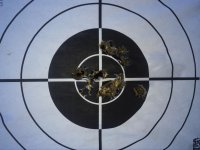Randy Lee
Member
Typically, the shorter barrels and slides will shoot more consistently in almost all polymer, striker fired pistols.If you get a chance to talk to Julie Golob or Dave Sevigny at a match, they will most likely agree as they both have seen this phenomenon when they were shooting for Team Glock.Randy, why doesn't the 9C have the same inherent issues as the full size. My compact is MUCH more accurate in comparison to my full size.
The main reason is that the bullet has a greater chance of exiting the barrel before barrel destabilization can take its toll (we are talking 9c, G26/G27 etc.).
The longer the barrel, the longer the time the bullet is in the barrel. If the system has too short of a dwell time then the trajectory of the bullet will have greater variability because the axis of the bore is pointed in slightly different directions.


